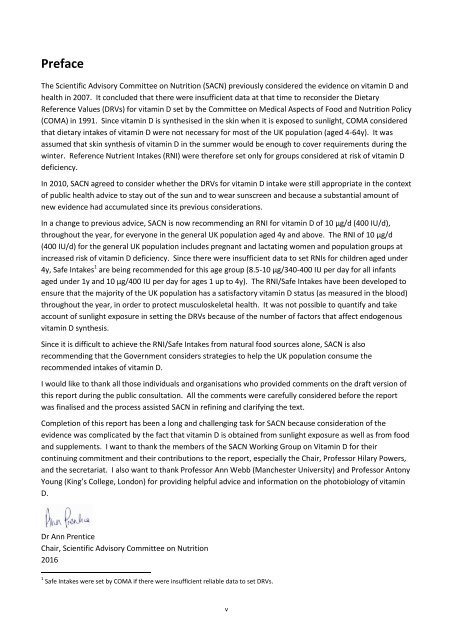Vitamin D and Health
SACN_Vitamin_D_and_Health_report
SACN_Vitamin_D_and_Health_report
Create successful ePaper yourself
Turn your PDF publications into a flip-book with our unique Google optimized e-Paper software.
Preface<br />
The Scientific Advisory Committee on Nutrition (SACN) previously considered the evidence on vitamin D <strong>and</strong><br />
health in 2007. It concluded that there were insufficient data at that time to reconsider the Dietary<br />
Reference Values (DRVs) for vitamin D set by the Committee on Medical Aspects of Food <strong>and</strong> Nutrition Policy<br />
(COMA) in 1991. Since vitamin D is synthesised in the skin when it is exposed to sunlight, COMA considered<br />
that dietary intakes of vitamin D were not necessary for most of the UK population (aged 4-64y). It was<br />
assumed that skin synthesis of vitamin D in the summer would be enough to cover requirements during the<br />
winter. Reference Nutrient Intakes (RNI) were therefore set only for groups considered at risk of vitamin D<br />
deficiency.<br />
In 2010, SACN agreed to consider whether the DRVs for vitamin D intake were still appropriate in the context<br />
of public health advice to stay out of the sun <strong>and</strong> to wear sunscreen <strong>and</strong> because a substantial amount of<br />
new evidence had accumulated since its previous considerations.<br />
In a change to previous advice, SACN is now recommending an RNI for vitamin D of 10 µg/d (400 IU/d),<br />
throughout the year, for everyone in the general UK population aged 4y <strong>and</strong> above. The RNI of 10 µg/d<br />
(400 IU/d) for the general UK population includes pregnant <strong>and</strong> lactating women <strong>and</strong> population groups at<br />
increased risk of vitamin D deficiency. Since there were insufficient data to set RNIs for children aged under<br />
4y, Safe Intakes 1 are being recommended for this age group (8.5-10 µg/340-400 IU per day for all infants<br />
aged under 1y <strong>and</strong> 10 µg/400 IU per day for ages 1 up to 4y). The RNI/Safe Intakes have been developed to<br />
ensure that the majority of the UK population has a satisfactory vitamin D status (as measured in the blood)<br />
throughout the year, in order to protect musculoskeletal health. It was not possible to quantify <strong>and</strong> take<br />
account of sunlight exposure in setting the DRVs because of the number of factors that affect endogenous<br />
vitamin D synthesis.<br />
Since it is difficult to achieve the RNI/Safe Intakes from natural food sources alone, SACN is also<br />
recommending that the Government considers strategies to help the UK population consume the<br />
recommended intakes of vitamin D.<br />
I would like to thank all those individuals <strong>and</strong> organisations who provided comments on the draft version of<br />
this report during the public consultation. All the comments were carefully considered before the report<br />
was finalised <strong>and</strong> the process assisted SACN in refining <strong>and</strong> clarifying the text.<br />
Completion of this report has been a long <strong>and</strong> challenging task for SACN because consideration of the<br />
evidence was complicated by the fact that vitamin D is obtained from sunlight exposure as well as from food<br />
<strong>and</strong> supplements. I want to thank the members of the SACN Working Group on <strong>Vitamin</strong> D for their<br />
continuing commitment <strong>and</strong> their contributions to the report, especially the Chair, Professor Hilary Powers,<br />
<strong>and</strong> the secretariat. I also want to thank Professor Ann Webb (Manchester University) <strong>and</strong> Professor Antony<br />
Young (King’s College, London) for providing helpful advice <strong>and</strong> information on the photobiology of vitamin<br />
D.<br />
Dr Ann Prentice<br />
Chair, Scientific Advisory Committee on Nutrition<br />
2016<br />
1 Safe Intakes were set by COMA if there were insufficient reliable data to set DRVs.<br />
v


